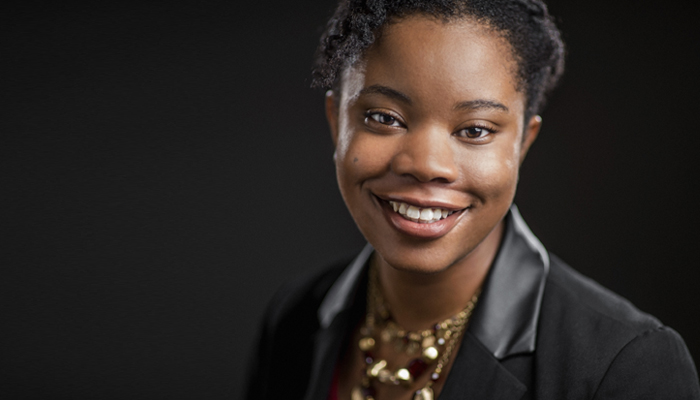HOW CAN WE HELP YOU? Call 1-800-TRY-CHOP
In This Section
Advancing Team Science: Q&A With Elease McLaurin, PhD, Diversity Fellow

Elease McLaurin, PhD
Editor's Note: Diversity is central to our breakthroughs at Children's Hospital of Philadelphia Research Institute. With a community of scientists from unique backgrounds and academic experiences, we are able to collaborate and confront pediatric problems from a variety of perspectives. In this four-part Q&A series, we're featuring four new scholars in the Postdoctoral Research Fellowship for Academic Diversity program at Children's Hospital of Philadelphia. As a key part of CHOP's commitment to diversity, this fellowship funds talented researchers and educators from different backgrounds, races, ethnic groups, and other diverse populations. Join us as these fellows share their areas of research and interest, what diversity in science means to them, and how they spend their hard-earned downtime.
In this Q&A, meet Elease McLaurin, PhD, a scientist who is gaining additional experience in conducting human factors research.
Please tell us about your background, and what compelled you to apply for the Postdoctoral Research Fellowship for Academic Diversity.
My academic background is predominantly in industrial engineering, which I like to colloquially describe as, "Other engineers make things (equipment, processes, etc.); industrial engineers make those things better." I specialized in human factors engineering, which is a blend of theories and methods from psychology, organizational design, data science, and ethnography applied to the design of sociotechnical systems.
For my dissertation, I developed new methods to analyze large datasets from on-road driving studies and applied them to characterizing the driving behavior of patients with severe obstructive sleep apnea, a condition that results in daytime fatigue and increased crash risk. I was co-advised by mentors in the Civil Engineering and the Industrial Engineering departments at the University of Wisconsin-Madison.
My dissertation work motivated me to continue conducting patient safety research. I chose to complete postdoctoral training to gain additional experience in conducting human factors research within the healthcare domain. I applied for the Postdoctoral Research Fellowship for Academic Diversity because of CHOP's widely recognized commitment to incorporating human factors in supporting both healthcare operations and translational research. The fellowship provided an opportunity to learn from leaders of these efforts and leverage my expertise to advance team science research projects.
Can you describe your area of research and why you chose it?
My research focuses on modelling the development and use of human skills in performing safety-critical activities within dynamic environments. This work involves both developing modelling approaches and generating domain knowledge of how performance is shaped by the activity context and individual differences. This research is used to guide the design and implementation of new technologies, practices, and policies intended to improve performance outcomes, such as reduced injury occurrence.
I chose this research area because of its tremendous potential to improve quality of life and health. Human-centered designs and implementation strategies are much more likely to achieve the desired outcome improvements. I also enjoy the highly collaborative nature of this type of research. The research projects involve partnering with domain experts in exploring ways to address practice challenges.
Tell us about a research project(s) you're excited about?
I am currently working on several interesting projects. One is focused on characterizing the driving behavior of newly licensed autistic teens. To conduct this study, we are instrumenting teens' vehicles with equipment to collect on-road driving performance data. The long-term goal is to develop tailored driver training materials that improve the success rate and safety of autistic teens who want to increase their mobility by obtaining a driver's license.
Another project is focused on developing and testing an interface for a clinical decision support tool designed to improve sepsis recognition in the neonatal ICU. As part of this project, I am conducting qualitative and quantitative analyses to identify interface design requirements so that the design complements the workflows of the intended clinical staff.
What does diversity in research and science mean to you?
In my work of improving the performance of sociotechnical systems, I often think about who is and is not well served by the current design. We live in a diverse world, so a lack of diversity in the people for whom a system works well is an indicator that the design needs to change. The limited diversity in the STEM profession and in the populations that most directly benefit from research are two such indicators. As a researcher and a member of the STEM profession, I consider it an important part of my work to be active in efforts to improve these systems in which I practice.
When you're not working, do you have a favorite pastime or spot to relax, enjoy a meal, or be active?
A long-time interest of mine is learning new jewelry-making techniques. When I'm not working, I enjoy perusing craft magazines and videos, taking technique classes, and designing projects to practice new skills. So far, the techniques I have learned span the range from basic ones like bead stringing, to highly intricate ones like lampwork (a form of glassblowing) beadmaking.


